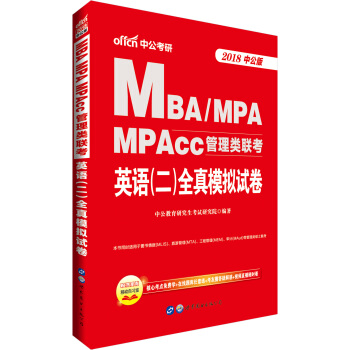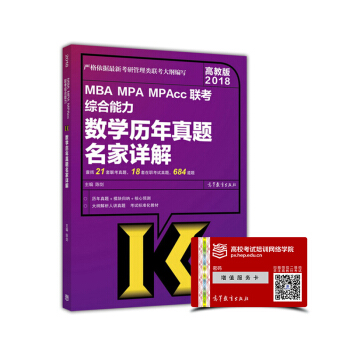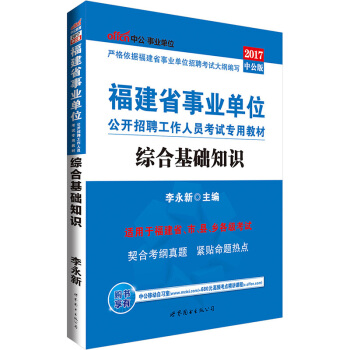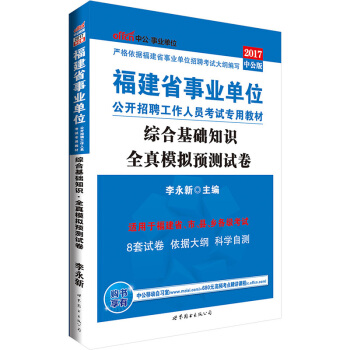

具体描述
编辑推荐
因印刷批次不同,图书封面可能与实际展示有所区别,增值服务也可能会有所不同,以读者收到实物为准。
《中公版·2018MBA、MPA、MPAcc管理类联考:英语(二)全真模拟试卷》是由具有丰富教学实践经验的中公教育研究生考试研究院师资编写,本书的主要特色如下:
1.8套模拟 检测实力
本书包含8套模拟试卷,试卷按照考场套题样式编排,内容严格依照大纲要求研发,题型、题量与试题难度均与真题相仿。考生通过模拟训练,可以检测自己对知识点的掌握情况。
2.深入研究 突出重点
本书编写组在深入研究出题规律的基础上,加大了对常考知识点的考查力度,有针对性地考查考生对出题重点的掌握水平。
3.解析详细 指点迷津
本书每套试卷都包含精心编写的答案解析。均附有答案速查、总体分析、试题详解、重点词汇和短语及全文翻译。考生可以先快速核对答案、进行自我测评,再仔细研读答案详解、总结做题方法,还可以结合重点词汇和短语、全文翻译来精读文章。
4.移动自习 随时随地
购书享有中公教育移动自习室多样增值服务,内含:核心考点免费学,在线题库任意练,考友圈答疑解惑,视频直播随时看。考生可利用碎片化时间,随时随地上自习。
考生在复习过程中,有任何疑惑都可以在微信考友圈提出,我们的老师会在第一时间去解答。
内容简介
《中公版·2018MBA、MPA、MPAcc管理类联考:英语(二)全真模拟试卷》是由中公考研师资根据多年来的理论探索和教学实践经验编写而成的。本书专为参加2018年管理类学位联考的考生量身定做,也适用于参加考研英语(二)的考生。全书共包括8套模拟试卷,试卷的题型、题量及难度与真题相仿。试卷严格按照考场套题样式编排,使考生身临其境,感受考试现场。精彩书评
NULL目录
2018年全国硕士研究生招生考试英语(二)全真模拟试卷12018年全国硕士研究生招生考试英语(二)全真模拟试卷2
2018年全国硕士研究生招生考试英语(二)全真模拟试卷3
2018年全国硕士研究生招生考试英语(二)全真模拟试卷4
2018年全国硕士研究生招生考试英语(二)全真模拟试卷5
2018年全国硕士研究生招生考试英语(二)全真模拟试卷6
2018年全国硕士研究生招生考试英语(二)全真模拟试卷7
2018年全国硕士研究生招生考试英语(二)全真模拟试卷8
精彩书摘
2018年全国硕士研究生招生考试英语(二)全真模拟试卷1
Section I Use of English
Directions:
Read the following text. Choose the best word(s) for each numbered blank and mark A, B, C or D on the ANSWER SHEET. (10 points)
We often tend to associate smiling as the result of a positive event or mood. But research demonstrates that the act of smiling, in and 1 itself, can be the catalyst for joy. Wonderful things, ranging from an 2 mood to a better relationship, can be the result of the 3 act of smiling. Even better, it is a tool that is free, easy and always available.
Even when you aren’t feeling happy, smile can help 4 your mood. Darwin hypothesized, back in 1872, that making changes in our 5 expressions can influence our 6 experience, something he called facial feedback response theory. Psychological research has 7 Darwin’s assertion that expressions do not just result from moods, but actually influence them.
Smiling more may actually 8 your lifespan. Research indicates that smiling may improve heart health by 9 heart rate after stressful events. So, 10 smiling to your health regime of eating well, getting enough sleep and exercising may just add 11 years to your life.
People who smile more tend to be more 12 , joyful and emotionally stable which lends itself to healthier relationships, and thus have longer and more successful 13 . An interesting study published in 2009 found a correlation between smiles in photographs and divorce rates. The larger the smile, the 14 likely divorce was later in life. 15 , those with the smallest smiles or no smiles, were five times more likely to be divorced.
When Mother Teresa said“Every time you smile at someone, it is ... a 16 to that person, a beautiful thing”, she was right. One study 17 by Hewlett Packard found that seeing another’s smile stimulated the heart and 18 more so than eating chocolate or receiving money. This was particularly true 19 viewing the smile of a child. Additionally, research has demonstrated smiling may actually be easily diffused. Research published in the Scandinavian Journal of Psychology examined mimicry, the tendency to mimic the emotional expressions of those around us, and found that it is actually hard to 20 when someone else is smiling.
1. [A] on [B] with [C] by [D] of
2. [A] impressed [B] improved [C] important [D] imposed
3. [A] pure [B] easy [C] simple [D] brief
4. [A] sack [B] shift [C] slip [D] switch
5. [A] facial [B] superficial [C] external [D] inner
6. [A] inward [B] outward [C] emotional [D] explicit
7. [A] formalized [B] declared [C] implemented [D] validated
8. [A] execute [B] expand [C] examine [D] expect
9. [A] accelerating [B] decreasing [C] facilitating [D] increasing
10. [A] leading [B] adding [C] contributing [D] resorting
11. [A] a little [B] little [C] few [D] a few
12. [A] optimistic [B] dispassionate [C] severe [D] cautious
13. [A] career [B] lifespan [C] marriage [D] friendship
14. [A] more [B] worse [C] less [D] better
15. [A] Consequently [B] Moreover [C] Conversely [D] Otherwise
16. [A] gift [B] regard [C] wish [D] grace
17. [A] discovered [B] converted [C] prepared [D] conducted
18. [A] stomach [B] brain [C] mindset [D] desire
19. [A] yet [B] when [C] though [D] unless
20. [A] sneer [B] blink [C] frown [D] breathe
Section Ⅱ Reading Comprehension
Part A
Directions:
Read the following four texts. Answer the questions below each text by choosing A, B, C or D. Mark your answers on the ANSWER SHEET. (40 points)
Text 1
“Project gold” and “Project Nexus” sound like plans for bank robberies or military attacks. In reality, they are the names for KPMG’s ongoing attempt to squeeze its 6,700 London employees into ever smaller spaces. Since 2006 the professional-services firm has reduced the number of offices it uses in London from seven to two. By the spring of 2015 everybody will be crammed into one building in CanaryWharf.
Firms have long known that only about half of all desks are in use at any moment, as employees work odd hours or disappear to meetings, but it was difficult to fill the spares. Better IT systems now mean that people need not be tied to a particular desk. They need not even be in the office at all: as cloud computing and virtual offices take off, more people are working from home or from other places, further reducing the need for desks.
Aside from cheapness, there is a motive behind this squashing. Inspired by Silicon Valley, firms are trying to make their offices into “collaborative spaces”, where people bump into each other and chat usefully. KPMG’s redesigned CanaryWharf offices will include lots of “breakout spaces” where employees can relax, and quiet rooms where people can get away from hubbub, says Alastair Young, who is planning the move. He thinks this will both improve productivity and save money.
In this happy new world, offices are not just places to work but also a way of expressing corporate identity and a means of attracting and retaining staff. At the offices of Bain & Company, a management consultancy, inspirational quotes on walls help workers to identify with Bain’s brand, explains Sam Axtell, the company’s operations director. Games rooms and relaxing spaces help them “release αwaves”.
Not everyone is delighted by the rise of cramped hot desks. At Broadcasting House, the BBC’s new offices in London, a shortage of good desks has led to frantic morning scrambles. A manager at a financial firm in the City complains that since his firm redesigned its office, there are only enough phones for one between two. KPMG has seen crushes at lifts and in the canteen; the crowds have also put pressure on the air-conditioning system.
21. It can be known that “Project gold” is a plan for .
[A] bank robberies
[B] military attacks
[C] squeezing employees
[D] squeezing working spaces
22. Better IT systems mean that workers .
[A] are tied to a particular desk
[B] are in the office all the day
[C] can work at home
[D] need more desks
23. All of the following are forms of new offices behind the squashing EXCEPT .
[A] noisy spaces
[B] collaborative spaces
[C] breakout spaces
[D] quiet rooms
24. Office in this happy new world is .
[A] just a place to work
[B] a place to attract new workers
[C] a place with little corporate identity
[D] a place to increase pressure
25. The examples of Broadcasting House and KPMG are used to explain that .
[A] morning scrambles are in all the places
[B] all the offices need to be redesigned
[C] not everyone is satisfied with the increasing cramped hot desks
[D] companies need to reduce the number of employees
用户评价
说实话,我拿到这本书,其实是抱着一种“试试看”的心态去翻阅的。我最看重的是它对官方考试大纲的把握度,一套好的模拟卷,绝对不是简单地把历年真题的难度上调一点或者换几个词汇那么肤浅。它应该能预判出当年可能出现的新的考察趋势,比如新词汇的组合方式,或者对某种特定语法的考察频率。我大概浏览了一下里面的试卷结构,感觉整体的布局和正式考试非常接近,这对于建立考场感觉至关重要。你知道吗,在紧张的考试环境下,任何一点陌生感都可能放大焦虑。如果模拟卷的版式和计时设置都能和正式考试高度同步,那么我在考场上就能更从容地分配时间。更让我好奇的是,它在作文部分的评分标准和范文解析上是否足够深入?管理类联考的写作,尤其是应用文写作,非常讲究格式和逻辑的严谨性,我希望它能提供那种“抠细节”的解析,而不是泛泛而谈的“多背单词”。如果解析能像一个经验丰富的老师在旁边手把手指导一样,那就太棒了。
评分说到底,模拟试卷这种东西,关键在于使用后的反思效率。如果做完一套题,解析简单潦草,我可能花半小时做完,花五分钟扫完答案就扔了,那它对我的提升微乎其微。我很关注这本《中公版》的解析部分,它是否能够提供“为什么选A而不是B”的深层次剖析?特别是对于那些容易混淆的选项,它能不能清晰地指出原文中哪句话是决定性的证据?我希望看到的是一种“解构”式的解析,把一道题目彻底拆解成考察点、难点和易错点。如果它能做到这一点,那么即使我把这套试卷做了好几遍,每一次都能从中挖掘出新的知识点,它就远远超出了普通模拟试卷的价值范畴,真正成为了我备考路上不可或缺的“精修工具书”,而不是一次性的“刷题工具”。这种深度解析的能力,往往区分了一流和二流的备考资料。
评分天哪,拿到这本《中公版·2018MBA、MPA、MPAcc管理类联考:英语(二)全真模拟试卷》的时候,我的心就悬着了。毕竟,MBA的考试对我来说就像一座难以逾越的大山,尤其是英语这块,简直是我的阿喀琉斯之踵。我之前也尝试过好几套所谓的“权威”模拟题,但做完之后总感觉和真题的难度和风格还是有点出入,要么是简单到让人昏昏欲睡,要么就是生僻词汇堆砌,完全脱离了联考的考察重点。所以,我对这套书的期望值是比较高的,希望它能真正贴合当年的考试热点和出题人的思维方式。我特别关注了它的排版和试卷的质量,毕竟是模拟卷,如果印刷模糊或者纸张太薄,做题体验会直线下降,长时间盯着做会很累。另外,我还想知道它在阅读理解部分的选材上是不是够“接地气”,毕竟管理类联考的阅读文章往往会涉及商业、经济、社会热点,而不是单纯的文学欣赏,我希望看到那些能真正考察我信息抓取和逻辑判断能力的材料。总而言之,第一印象就是,希望它能成为我冲刺阶段最可靠的“陪练”,而不是又一套只能束之高阁的“安慰剂”。
评分经过我初步的体验,这套模拟试卷给我的感觉是“扎实”中带着一丝“狡黠”。所谓的“扎实”,是指它的基础部分,比如词汇和完形填空的选择,难度梯度设置得比较合理,没有那种故意设置陷阱的低级错误,更像是对基础知识点进行系统性的查漏补缺。但那个“狡黠”的点就在于阅读理解。我做了一套之后发现,它不像有些模拟卷那样直接搬运外刊文章的原文,而是似乎对原文章进行了细微的改写和重组,这使得你在做题时,即使记住了某些技巧,也无法直接套用,必须回归到文本本身去理解作者的真实意图。这种出题思路非常接近联考那种“不走寻常路”的风格,它考察的不是你背了多少阅读技巧,而是你的英语思维能力是否已经真正形成了。我甚至觉得,有些文章的逻辑链条比某些当年的真题还要绕一点,这无疑是对我深度思考能力的一个绝佳的锻炼。
评分从一个常年与应试材料打交道的“老油条”的角度来看,这套模拟卷的价值点在于它的“时效性”和“针对性”。2018年的考试,意味着它必须紧密结合前一两年社会和经济领域的重大事件来设置阅读材料。我特地去对比了一下其中几篇阅读文章的主题,发现它们确实触及了一些当时的热点话题,这说明编写团队在信息收集和素材选择上是下了功夫的,而不是用几年前的旧材料来凑数。另外,对于听力部分,我一直觉得这是很多考生,包括我自己在内容易忽略的“隐形杀手”。这套模拟卷的听力材料的语速和口音多样性都做得不错,没有那种过于标准化的“播音腔”,更贴近真实考试中可能出现的口音和语境切换。如果它的配套音频质量能够保持一致的高水准,那它在听力训练上的贡献将是不可估量的。毕竟,听力一旦丢分,后面再怎么努力也难以弥补。
评分京东的品质一直非常信赖,不出门什么都可以买到,真是方便。试卷非常好,里面的题扫二维码都有解题讲解,非常清晰,没有广告。
评分比较多内容是抄各家学校的招生指南,短文材料有一定帮助。
评分送货速度快,不得不说京东物流杠杠的,书的质量也好,买了好多本,希望自己努力一点吧,懒癌患者??(??ω???)
评分挺不错的,做了一份英语试卷,能考95分,看来只要把综合联考搞定就能稳上线了
评分书有点儿旧,装订不齐,裁剪毛糙,纸张质量一般~ 这是正版吗?
评分不错,物流挺快的,我也挺喜欢!
评分不错不错,送的很快,非常满意
评分好!此评论虽然只有一个字,却深刻的表达了回复人的深深祝福与刻骨的情感,可谓言简意骇,一字千金,字字扣人心弦,字字催人泪下,足可见评论人扎实的文字功底和信手拈来的写作技巧以及惨绝人寰的创新能力。再加上以感叹号收尾,点睛之笔,妙笔生花,意境深远,照应前文,升华主题
评分还没开始看,感觉内容很全,也不是买了一定要考,多学点东西吧。
相关图书
本站所有内容均为互联网搜索引擎提供的公开搜索信息,本站不存储任何数据与内容,任何内容与数据均与本站无关,如有需要请联系相关搜索引擎包括但不限于百度,google,bing,sogou 等,本站所有链接都为正版商品购买链接。
© 2025 windowsfront.com All Rights Reserved. 静流书站 版权所有




















![专业英语考研基础英语高分突破(全新精华版) [Mastering Advanced English Proficiency] pdf epub mobi 电子书 下载](https://pic.windowsfront.com/10096392/53956bf0Nade8b4cf.jpg)